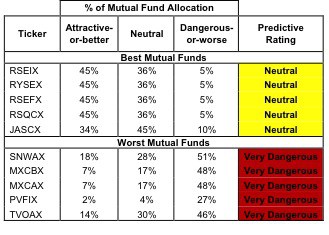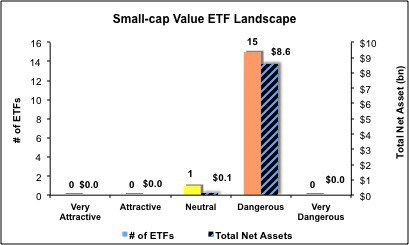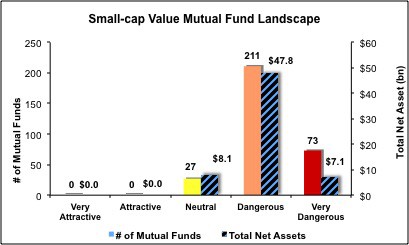The small-cap value style ranks last out of the twelve fund styles as detailed in my style roadmap. It gets my Dangerous rating, which is based on aggregation of ratings of 16 ETFs and 311 mutual funds in the small-cap value style as of July 20, 2012. Reports on the best & worst ETFs and mutual funds in every sector and style are here.
Figures 1 and 2 show the five best and worst-rated ETFs and mutual funds in the style. Not all small-cap value style ETFs and mutual funds are created the same. The number of holdings varies widely (from 19 to 1681), which creates drastically different investment implications and ratings. The best ETFs and mutual funds allocate more value to Attractive-or-better-rated stocks than the worst, which allocate too much value to Neutral-or-worse-rated stocks.
To identify the best and avoid the worst ETFs and mutual funds within the small-cap value style, investors need a predictive rating based on (1) stocks ratings of the holdings and (2) the all-in expenses of each ETF and mutual fund. Investors need not rely on backward-looking ratings. My fund rating methodology is detailed here.
Investors should not buy any small-cap value ETFs or mutual funds because none get an Attractive-or-better rating. If you must have exposure to this style, you should buy a basket of Attractive-or-better rated stocks and avoid paying undeserved fund fees. Active management has a long history of not paying off.
See ratings and reports on all ETFs and mutual funds in this style on my free mutual fund and ETF screener.
Figure 1: ETFs with the Best & Worst Ratings – Top 5
* Best ETFs exclude ETFs with less NAV’s less than 100 million.
Sources: New Constructs, LLC and company filings
Six ETFs are excluded from Figure 1 because their total net assets (TNA) are below $100 million and do not meet our liquidity standards.
Figure 2: Mutual Funds with the Best & Worst Ratings – Top 5
* Best mutual funds exclude funds with NAV’s less than 100 million.
Sources: New Constructs, LLC and company filings
Small Cap Value Fund, Inc. SCAPX is excluded from Figure 2 because its total net assets (TNA) are below $100 million and do not meet our liquidity standards.
WisdomTree SmallCap Earnings Fund EES is my top-rated small-cap value ETF and Royce Fund: Royce Special Equity Fund RSEIX is my top-rated small-cap value mutual fund. Both earn my Neutral rating.
Rydex S&P Smallcap 600 Pure Value RZV earns my Dangerous rating and is my worst-rated small-cap value ETF. Touchstone Funds Group Trust: Touchstone Small Cap Value Fund TVOAX earns my Very Dangerous rating and is my worst-rated small-cap value mutual fund.
Figure 3 shows that 439 out of the 2302 stocks (25% of the total net assets) held by small-cap value ETFs and mutual funds earn an Attractive-or-better rating. However, none of the 16 ETFs or 311 mutual funds allocate enough value to the 439 stocks to earn an Attractive-or-better rating.
The takeaways: small-cap value managers pick poor quality stocks and small-cap value ETFs offer exposure to poor quality stocks.
Figure 3: Small-cap Value Style Landscape For ETFs, Mutual Funds & Stocks
As detailed in “Cheap Funds Dupe Investors”, the fund industry offers many cheap funds but very few funds with high-quality stocks, or with what I call good portfolio management.
Investors should not buy any small-cap value ETFs and mutual funds. None of the small-cap value ETFs or mutual funds are worth buying. In fact 98% of ETFs and 91% of mutual funds earn a Dangerous-or-worse rating and should be avoided.
Plantronics, Inc. PLT is one of my favorite stocks held by small-cap value ETFs and mutual funds and earns my Very Attractive rating. PLT’s management has proven to be effective stewards of capital. The company has generated a return on invested capital (ROIC) over its weighted average cost of capital (WACC) for the past 14 years. Over the past four years, the company has increased its ROIC from 8.2% to an impressive 28.4%, which places PLT in the 95th percentile of all Russell 3000 companies. Over the same time period the company has increased after-tax profits (NOPAT) by an average of 43% a year. In spite of strong past performance, PLTs current stock price (~$32.81) implies that profits will permanently decrease by 10%. Strong past performance and low expectations for future performance make PLT an excellent long candidate.
PowerSecure International, Inc. POWR is one of my least favorite stocks held by small-cap value ETFs and mutual funds and earns my Very Dangerous rating. The company’s ROIC has deteriorated from 28.5% in 2006 to a disappointing 0.5% in 2011. The declining ROIC has caused the company to destroy value in each of the past three years. To justify its current stock price, POWR must grow profits by 31.7% compounded annually for 17 years. This is a high hurdle given the recent downward spiral in profits.
Figures 4 and 5 show the rating landscape of all small-cap value ETFs and mutual funds.
Our style roadmap report ranks all styles and highlights those that offer the best investments.
Figure 4: Separating the Best ETFs From the Worst Funds
Figure 5: Separating the Best Mutual Funds From the Worst Funds
Review my full list of ratings and rankings along with free reports on all 16 ETFs and 311 mutual funds in the small-cap value style.
Disclosure: I own PLT. I receive no compensation to write about any specific stock, sector, style or theme.
© 2025 Benzinga.com. Benzinga does not provide investment advice. All rights reserved.
Trade confidently with insights and alerts from analyst ratings, free reports and breaking news that affects the stocks you care about.




